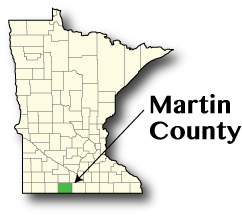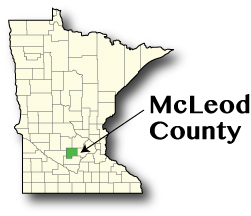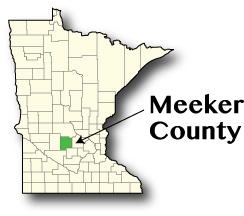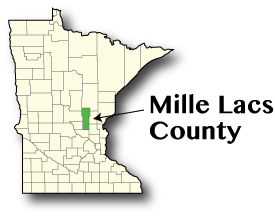by Cameron Macht
March 2018

Martin County is located on the Iowa border in South Central Minnesota, Martin County has a long history of pioneer settlers. Although named for Henry Martin, an early pioneer, perhaps the county's most famous settler was William H. Budd. A carpenter, soldier, and community builder, Budd walked from Mankato to Martin County on foot and purchased a squatter's right for $50 to build his cabin in what would become Fairmont, which he helped name and select as the county seat. One of the county's first commissioners, he also compiled and published Martin County Before 1880, a book about the early history of Martin County.1
Martin County's population peaked at 26,986 residents in 1960 and had fallen to just under 20,000 people by 2016, making it the 49th largest county in the state. The county's median age tipped past 45 years, including 38.3 percent of the county's population that was 55 years and over, compared to 28.6 percent statewide. Projections from the State Demographic Center show continued population declines in the future, dropping to 17,886 people in 2040, similar to the county's population in 1910. Interstate 90 runs through Martin County, leading to a net labor export, with many residents driving west to Jackson County, east to Faribault County, or north to Blue Earth County for work.
Health Care and Social Assistance is the largest employing sector in Martin County with 1,586 jobs at 66 establishments. The next largest sector is Retail Trade with 1,271 jobs at 85 stores, accounting for 14.3 percent of total employment in the county. The two biggest specialties include Food and Beverage stores and General Merchandise stores, accounting for over half of the county's retail employment. Although it has seen job cuts in recent years, Martin County also retained a prominent Manufacturing sector, with 1,211 jobs at 35 firms, accounting for 13.7 percent of total employment. Although also suffering declines, the related Wholesale Trade sector had extremely high wages in the county.
| Estimates | Martin County | Minnesota |
|---|---|---|
| Population, 2016 | 19,829 | 5,519,952 |
| Labor Force, 2017 | 10,398 | 3,046,697 |
| Average Unemployment, 2017 | 3.7% | 3.6% |
| Median Household Income, 2016 | $51,984 | $63,217 |
| Cost of Living, Individual, 2017 | $24,248 | $29,856 |
| Cost of Living, Average Family, 2017 | $42,291 | $55,200 |
| Source: U.S. Census Bureau, DEED Local Area Unemployment Statistics, American Community Survey, DEED Cost of Living Survey | ||
| Top Industries of Employment | Qtr. 3 2017 Data | Qtr. 3 2007 - Qtr. 3 2017 | |||
|---|---|---|---|---|---|
| Number of Firms | Number of Jobs | Average Wage | Change in Jobs | Change in Wages | |
| Total, All Industries | 665 | 8,865 | $40,612 | -7.5% | 31.3% |
| Education and Health Services | 80 | 2,156 | $42,380 | -6.3% | 28.1% |
| Trade, Transportation, and Utilities | 157 | 2,042 | $50,752 | -7.4% | 41.9% |
| Manufacturing | 35 | 1,211 | $47,268 | -24.0% | 26.8% |
| Leisure and Hospitality | 56 | 925 | $11,908 | -6.8% | 34.7% |
| Source: DEED Quarterly Census of Employment and Wages | |||||

Created and organized in 1856, McLeod County was named for Martin McLeod, a Scotsman who was one of the first settlers in the area.2 Although Hutchinson is the largest city in the county – and with about 14,000 residents it is classified as a Micropolitan Statistical Area – the county seat is located in Glencoe, with a population of about 5,500 people. Nestled just to the west of the Twin Cities metro area, McLeod County is also now considered a part of the Minneapolis-St. Paul MN-WI combined statistical area.
McLeod County's population was still growing through the last Census in 2010, but has since seen small declines caused by economic changes. With Hutchinson operating as a regional center, McLeod draws just over 7,100 workers from surrounding counties for work. It also loses nearly 8,800 residents to work in other places, primarily to Hennepin, Carver, Wright, and Ramsey counties in the Twin Cities metro area. Another 9,505 residents both live and work in McLeod County.
With 4,981 jobs at 78 establishments, Manufacturing provided almost one-third (30.4%) of total employment in the county in 2017. At that level, McLeod County had the third highest concentration of Manufacturing jobs of the 87 counties in the state. However, several of the largest Manufacturing specialties in the county have sliced significant numbers of jobs over the last decade, including Computer and Electronic Product Manufacturing and Food Manufacturing, while both Fabricated Metal Product Manufacturing and Machinery Manufacturing have been expanding in recent years.
| Estimates | McLeod County | Minnesota |
|---|---|---|
| Population, 2016 | 35,842 | 5,519,952 |
| Labor Force, 2017 | 19,301 | 3,046,697 |
| Average Unemployment, 2017 | 4.0% | 3.6% |
| Median Household Income, 2016 | $57,738 | $63,217 |
| Cost of Living, Individual, 2017 | $26,892 | $29,856 |
| Cost of Living, Average Family, 2017 | $46,290 | $55,200 |
| Source: U.S. Census Bureau, DEED Local Area Unemployment Statistics, American Community Survey, DEED Cost of Living Survey | ||
| Top Industries of Employment | Qtr. 3 2017 Data | Qtr. 3 2007 - Qtr. 3 2017 | |||
|---|---|---|---|---|---|
| Number of Firms | Number of Jobs | Average Wage | Change in Jobs | Change in Wages | |
| Total, All Industries | 914 | 16,376 | $43,108 | -11.4% | 23.2% |
| Manufacturing | 78 | 4,981 | $58,812 | -29.1% | 25.9% |
| Education and Health Services | 108 | 3,681 | $41,704 | 17.7% | 24.3% |
| Trade, Transportation, and Utilities | 209 | 3,067 | $31,824 | -10.9% | 28.3% |
| Leisure and Hospitality | 79 | 1,350 | $14,820 | -1.0% | 50.8% |
| Source: DEED Quarterly Census of Employment and Wages | |||||

Inspired by such a strange vacation destination, Weird Al Yankovic once wrote a song about "The Biggest Ball of Twine in Minnesota"3 which was created by one man in Darwin, located in Meeker County. According to the story on RoadsideAmerica, Francis A. Johnson started rolling the ball in his basement in 1950, four hours a day every day, until 1979, when it was 12 feet wide and weighed almost 9 tons.4 Visitors can see the twine ball enclosed in a Plexiglas and wood gazebo.
Geographically positioned in the middle of the state from east to west, Meeker County is also in the middle as the 43rd largest county with just over 23,000 people and was the 42nd fastest growing county from 2000 to 2016, gaining 2.1 percent. With nearly 7,000 residents who live in Meeker County but work elsewhere – primarily in other regional centers like St. Cloud, Hutchinson, Willmar, and the Twin Cities – Meeker County is a bit of a bedroom community. In comparison, 4,563 residents both lived and worked in Meeker County, and local employers welcomed an inflow of 2,900 commuters from other counties.
Strangely, Meeker County's labor force grew more than its population from 2000 to 2016 – the county added 828 more workers compared to 466 additional residents. The recent workforce growth has helped employers fill jobs – the county's economy added nearly 500 jobs over the past decade. Meeker County has higher-than-average labor force participation rates for workers aged 45 years and over and for people with lower educational attainment.
One in every five jobs in the county is in Manufacturing, spread most notably across the Machinery, Fabricated Metal Products, and Transportation Equipment manufacturing specialties. After adding almost 100 jobs over the past 10 years, Health Care and Social Assistance is the next largest industry, including 685 jobs at 17 nursing and residential care facilities and catering to the county's aging population. But almost two-thirds of the county's job growth since 2007 occurred in Trade, Transportation, and Utilities, primarily in Retail and Wholesale Trade, which added 223 and 97 jobs, respectively.
| Estimates | Meeker County | Minnesota |
|---|---|---|
| Population, 2016 | 23,110 | 5,519,952 |
| Labor Force, 2017 | 13,192 | 3,046,697 |
| Average Unemployment, 2017 | 4.2% | 3.6% |
| Median Household Income, 2016 | $58,574 | $63,217 |
| Cost of Living, Individual, 2017 | $28,787 | $29,856 |
| Cost of Living, Average Family, 2017 | $48,244 | $55,200 |
|
Source: U.S. Census Bureau, DEED Local Area Unemployment Statistics, American Community Survey, DEED Cost of Living Survey |
||
| Top Industries of Employment | Qtr. 3 2017 Data | Qtr. 3 2007 - Qtr. 3 2017 | ||
|---|---|---|---|---|
| Number of Firms | Number of Jobs | Average Wage | Change in Jobs | |
| Total, All Industries | 603 | 7,418 | $36,660 | 7.1% |
| Education and Health Services | 67 | 1,773 | $33,696 | 10.4% |
| Trade, Transportation, and Utilities | 148 | 1,589 | $33,748 | 26.1% |
| Manufacturing | 54 | 1,436 | $47,112 | 4.0% |
| Source: DEED Quarterly Census of Employment and Wages | ||||

Mille Lacs County consists of 685 square miles, of which 583 square miles is land and 102 square miles is water – with Lake Mille Lacs covering two-thirds of the northern boundary of the county.5 Encompassing more than 132,500 acres and with a maximum depth of 42 feet6, Mille Lacs Lake is the second largest inland lake in the state, surrounded by at least 27 lodging establishments.7 But that's not all – the name "mille lacs" means "thousand lakes" in French. Other major lakes in the county include Ogechie, Shakopee, Onamia, Clear, Mud, Cranberry, Rice, Silver, and a portion of Whitefish Lake.
With more than 1,300 American Indian residents comprising 5.1 percent of the population, Mille Lacs County has the 7th highest concentration in the state. The number of American Indians increased more than twice as fast as the county's white population from 2000 to 2016, although whites still account for 91 percent of the total population. The county's second largest minority group was people of two or more races, which nearly tripled since 2000, up to 650 residents.
At 5.7 percent in 2017, Mille Lacs County continued to have one of the highest unemployment rates in the state, ranking 12th in 2017 after peaking at 12.5 percent and hovering as high as 3rd during the recession from 2008 to 2010. While unemployment rates have dropped to 5.5 percent for whites, they remain above 20 percent for the 500 American Indian workers in Mille Lacs County.
Mille Lacs County's economy is dependent on tourism, with nearly one-third of the county's jobs found in Leisure and Hospitality and in Retail Trade. These industries, however, have cut 375 jobs over the past decade, and they tend to offer relatively low wages. In contrast, Education and Health Services have seen steady growth in Mille Lacs County since 2007 and offered higher wages. Partially because American Indian tribal governance is classified as Local Government and also with 1,166 jobs, Public Administration – particularly Executive, Legislative, and Other Government Support – was a leading industry in Mille Lacs County, and offered average annual wages that were $10,000 higher than the total of all industries.
| Estimates | Mille Lacs County |
|---|---|
| Population, 2016 | 25,866 |
| Labor Force, 2017 | 12,901 |
| Average Unemployment, 2017 | 5.7% |
| Median Household Income, 2016 | $51,232 |
| Cost of Living, Individual, 2017 | $30,307 |
| Cost of Living, Average Family, 2017 | $52,711 |
| Source: U.S. Census Bureau, DEED Local Area Unemployment Statistics, American Community Survey, DEED Cost of Living Survey | |
| Top Industries of Employment | Qtr. 3 2017 Data | Qtr. 3 2007 - Qtr. 3 2017 | |||
|---|---|---|---|---|---|
| Number of Firms | Number of Jobs | Average Wage | Change in Jobs | Change in Wages | |
| Total, All Industries | 684 | 9,618 | $35,204 | -3.4% | 28.2% |
| Education and Health Services | 77 | 2,551 | $38,532 | 8.2% | 29.1% |
| Leisure and Hospitality | 86 | 2,107 | $19,968 | -12.5% | -1.8% |
| Trade, Transportation, and Utilities | 152 | 1,369 | $27,976 | -8.9% | 24.8% |
| Public Administration | 26 | 1,166 | $45,864 | -12.5% | 42.3% |
| Source: DEED Quarterly Census of Employment and Wages | |||||
1William Hampton Budd. Martin County Historical Society
2About McLeod County. McLeod County Minnesota.
3"Weird Al Yankovic. The Biggest Ball of Twine in Minnesota."
4"World's Largest Twine Ball." RoadsideAmerica.
5"History of the County." Mille Lacs County.
6"Lakes, rivers, and wetland facts." Minnesota Dept. of Natural Resources.
7"Where to Stay." Lake Mille Lacs.